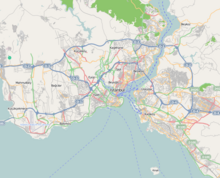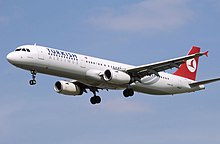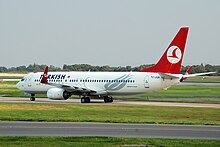Atatürk International Airport
Atatürk Uluslararası Havalimanı |
|---|
 |
| IATA: IST – ICAO: LTBA |
|---|
| Summary |
|---|
| Airport type | Public |
|---|
| Owner | General Directorate of State Airports |
|---|
| Operator | TAV Airport Management |
|---|
| Serves | Istanbul, Turkey |
|---|
| Location | Yeşilköy |
|---|
| Hub for | *Turkish Airlines
*Atlasjet
*Onur Air |
|---|
| Elevation AMSL | 163 ft / 50 m |
|---|
| Coordinates |  40°58′34″N 028°48′51″E 40°58′34″N 028°48′51″E |
|---|
| Website | www.ataturkairport.com |
|---|
| Map |
|---|
| Location within Istanbul |
| Runways |
|---|
| Direction | Length | Surface |
|---|
| m | ft |
|---|
| 17L/35R | 3,000 | 9,843 | Concrete |
| 17R/35L | 3,000 | 9,843 | Concrete |
| 05/23 | 2,600 | 7,546 | Grooved Asphalt |
| Statistics (2009) |
|---|
| Total passengers | 29,757,384 |
|---|
| International Passengers | 18,363,739 |
|---|
| Sources: Turkish AIP at EUROCONTROL |
Atatürk International Airport (IATA: IST, ICAO: LTBA)(Turkish: Atatürk Uluslararası Havalimanı) is the major international airport in Istanbul, Turkey. Opened in 1924 and located in Yeşilköy, on the European side of the city, it is 24 km (15 mi) west of the city centre. In 1980, the airport was renamed to Atatürk International Airport in honor of Mustafa Kemal Atatürk, the founder and the first president of the Republic of Turkey. With total passenger traffic of 30 million for the year 2009, it is among the top 40 airports in the world in terms of total passenger traffic and the 20th busiest in the world in terms of international passenger traffic. It is Europe's 9th busiest airport.
Runways
There is a plan to build another runway parallel to runway 05/23, so when the original runway 05/23 is under repair, this runway will be able to handle the traffic without any problem. But to work on this project, the military land is a fact of negotiation between the authorities as the space for new runway belongs to military. Also there are plans to expand the length of the runway 05/23 as well, by this way, runway will be able to handle larger aircraft as most airlines started to fly to Istanbul with larger aircraft..
Terminals, airlines and destinations
Atatürk airport has four terminals:
Terminal A, for domestic flights
Terminal B, for international flights
Terminal C, for cargo flights
General Aviation Terminal
Inaugurated in 2001, the international terminal is an efficient and modern terminal. After the new terminal opened, domestic flights were moved to the old international terminal. Despite its 1970s design, this new domestic terminal can handle more passengers than the more modern but smaller previous domestic terminal.
The airport terminals have been operated by TAV (Tepe-Akfen-Ventures) since January 2000. TAV has invested US$600 million since 1998. In 2005 TAV won the concession agreement to operate Atatürk for 15.5 years at a record breaking amount of $3 billion, which also represents the highest figure for such a privatization project in Turkey, Eastern Europe, Middle East, Commonwealth of Independent States and North Africa.
TAV (Tepe-Akfen-Ventures) started its construction at the airport for new boarding gates at international terminal as well as building a new air traffic control tower. Unused facility buildings are demolished and 3 new boarding bridges are being built. When the new tower is completed, the old one will be demolished.When the international terminal is expanded, some of the jet ways will be left to the domestics terminal which are on the west of the international terminal, connected to it.
Passenger
Airlines Destinations Terminal
Adria Airways Ljubljana B
Aegean Airlines Athens B
Aeroflot Moscow-Sheremetyevo B
Aerosvit Airlines Dnepropetrovsk, Donetsk, Kiev-Boryspil, Odessa, Simferopol B
Air Algérie Algiers, Constantine, Oran B
Air Astana Almaty, Astana, Atyrau B
Air France Paris-Charles de Gaulle B
Air Malta Malta B
Air Moldova Chişinău B
Air Transat Seasonal: Montreal-Trudeau [begins 15 May], Toronto-Pearson [begins 15 May] TBA
airBaltic Riga B
Albanian Airlines Tirana B
Alitalia Rome-Fiumicino, Turin B
Ariana Afghan Airlines Kabul B
Armavia Yerevan B
Asiana Airlines Seoul-Incheon [resumes 27 March] B
Atlasjet Antalya, Bodrum, Izmir A
Atlasjet Arbil, Ercan, Pristina, Sulaimaniyah B
Austrian Airlines Vienna B
Austrian operated by Tyrolean Airways Vienna B
Azerbaijan Airlines Baku B
Azmar Airlines Sulaimaniyah B
Belavia Minsk B
Berkut Air Astana B
B&H Airlines Sarajevo B
British Airways London-Heathrow B
Buraq Air Tripoli, Benghazi B
Caspian Airlines Tehran-Imam Khomeini B
Corendon Airlines Amsterdam, Tehran-Imam Khomeini B
Croatia Airlines Zagreb [begins March 27] B
Delta Air Lines New York-JFK B
Donavia Rostov-on-Don, Sochi B
Donbassaero Donetsk B
Dniproavia Dnipropetrovsk B
Eastok Avia Sulaimaniyah B
EgyptAir Cairo B
Emirates Dubai B
Etihad Airways Abu Dhabi B
Finnair Helsinki [ends April 11] B
Freebird Airlines Madrid B
Gulf Air Bahrain B
Iberia Madrid B
Iran Air Tabriz, Tehran-Imam Khomeini B
Iraqi Airways Baghdad, Basra[2] B
Jat Airways Belgrade B
Jetairfly Brussels South-Charleroi B
Kish Air Tehran-Imam Khomeini B
KLM Amsterdam B
Korean Air Seoul-Incheon B
Kuban Airlines Krasnodar B
Libyan Airlines Benghazi, Tripoli B
LOT Polish Airlines Warsaw B
Lufthansa Düsseldorf, Frankfurt, Munich B
Mahan Air Tehran-Imam Khomeini B
Malaysia Airlines Kuala Lumpur B
Malév Hungarian Airlines Budapest B
Middle East Airlines Beirut B
Motor Sich Airlines Zaporizhia B
Nile Air Cairo B
Nouvelair Monastir B
Olympic Air Athens B
Onur Air Adana, Antalya, Bodrum, Dalaman, Diyarbakır, Erzurum, Gaziantep, Izmir, Malatya, Samsun, Trabzon A
Pakistan International Airlines Abu Dhabi, Islamabad B
Pegasus Airlines operated by IZair İzmir A
Polet Airlines Voronezh B
Qatar Airways Doha B
Red Wings Airlines Moscow-Vnukovo B
Rossiya St Petersburg B
Royal Air Maroc Casablanca B
Royal Jordanian Amman-Queen Alia B
Sky Airlines Antalya, Hamburg, Tel Aviv A,B
Somon Air Dushanbe B
Saudi Arabian Airlines Jeddah, Madinah, Riyadh B
SCAT Aktau B
Singapore Airlines Singapore B
SkyExpress Moscow-Vnukovo B
Swiss International Airlines Zürich B
Syrian Air Aleppo, Damascus B
Tailwind Airlines Düsseldorf B
Tajikistan Airlines Dushanbe B
TAROM Bucharest-Otopeni B
Tatarstan Airlines Kazan B
Tunis Air Tunis B
Turkish Airlines Adana, Adıyaman, Ağrı, Ankara, Antalya, Batman, Bodrum, Çanakkale, Dalaman, Denizli, Diyarbakir, Elazığ, Erzincan, Erzurum, Eskişehir, Gaziantep, Hatay, Isparta, İzmir, Kahramanmaraş, Kars, Kayseri, Konya, Malatya, Mardin, Merzifon, Muş, Nevşehir, Samsun, Şanlıurfa, Sinop, Sivas, Trabzon, Uşak, Van A
Turkish Airlines Abu Dhabi, Accra, Addis Ababa, Aleppo, Alexandria-Borg el Arab, Algiers, Almaty, Amman, Amsterdam, Ashgabat, Astana, Athens, Baghdad, Bahrain, Baku, Bangkok-Suvarnabhumi, Barcelona, Batumi, Basel/Mulhouse, Beijing-Capital, Beirut, Belgrade, Benghazi, Berlin-Tegel, Birmingham, Bishkek, Bologna, Brussels, Bucharest-Otopeni, Budapest, Cairo, Cape Town, Casablanca, Chicago-O'Hare, Chişinău, Cologne/Bonn, Copenhagen, Dakar, Damascus, Dar es Salaam, Delhi, Dhaka, Dnepropetrovsk, Doha, Donetsk, Dubai, Dublin, Dushanbe, Düsseldorf, Entebbe, Frankfurt, Geneva, Gothenburg-Landvetter, Guangzhou [begins 30 January], Hamburg, Hanover, Helsinki, Ho Chi Minh City, Hong Kong, Jakarta-Soekarno-Hatta, Jeddah, Johannesburg, Karachi, Kazan, Khartoum, Kiev-Boryspil, Kuwait, Lagos, Lisbon, Ljubljana, London-Heathrow, Los Angeles [begins 3 March], Lviv, Lyon, Madinah, Madrid, Manchester, Mashhad, Milan-Malpensa, Minsk, Moscow-Sheremetyevo, Mumbai, Munich, Muscat, Nairobi, New York-JFK, Nice, Nicosia-Ercan, Nuremberg, Odessa, Osaka-Kansai, Oslo-Gardermoen, Paris-Charles de Gaulle, Podgorica, Prague, Pristina, Riga, Riyadh, Rome-Fiumicino, Rostov-on-Don, St Petersburg, Sana'a, São Paulo-Guarulhos, Sarajevo, Seoul-Incheon, Shanghai-Pudong, Shiraz, Simferopol, Singapore, Skopje, Sochi, Sofia, Stockholm-Arlanda, Stuttgart, Tabriz, Tashkent, Tbilisi, Tehran-Imam Khomeini, Tel Aviv, Tirana, Tokyo-Narita, Toronto-Pearson, Tripoli, Tunis, Ufa, Venice-Marco Polo, Vienna, Warsaw, Washington-Dulles, Yekaterinburg, Zagreb, Zürich B
Turkmenistan Airlines Ashgabat B
Turkuaz Airlines Hanover, Stuttgart B
Uzbekistan Airlines Tashkent B
Wataniya Airways Kuwait B
Viking Hellas Erbil, Rhodes B
Wind Rose Aviation Kiev-Boryspil B
[edit]Cargo airlines
Airlines Destinations
ACT Airlines Hong Kong, New York-JFK, Lahore, Singapore, Tallinn
Air France Cargo operated by MNG Cargo Paris-Charles de Gaulle
Cargolux Luxembourg
DHL Aviation operated by MNG Cargo Leipzig/Halle
EgyptAir Cargo Cairo
Fedex operated by MNG Cargo Brussels
Jade Cargo International Hong Kong
KLM Cargo operated by Martinair Cargo Amsterdam
Korean Air Cargo Incheon
Kuzu Airlines Cargo Amsterdam, Dubai, Kuwait, London-Gatwick
Lufthansa Cargo Frankfurt
MASkargo Kuala Lumpur
MNG Cargo Hahn, London-Luton, Milan-Malpensa, Tallinn, Tel Aviv
Qatar Airways Cargo operated by MNG Cargo Doha
Royal Jordanian Cargo Amman
TNT Airways Europe
Turkish Airlines Cargo Algiers, Almaty, Amman, Beirut, Cairo, Casablanca, Cologne/Bonn, Damascus, Dubai, Frankfurt, London-Gatwick, Maastricht/Aachen, Madrid, Milan-Malpensa, Paris-Charles de Gaulle, Pristina, Tbilisi, Tel Aviv, Tripoli, Tirana, Zürich
ULS Airlines Cargo Beijing, Hong Kong, Manila, Manston, Shanghai
UPS Airlines Europe
Other facilities
Turkish Airlines has its headquarters in the Turkish Airlines General Management Building, located on the airport property.
Traffic
 |
| A view from the interior of the international terminal. |
Atatürk Airport still faces capacity issues; it ranks somewhere between 30th and 40th in the world by both cargo and passenger traffic, handling over 825,000 tonnes of load (cargo, freight and mail) and over 30 million passengers in the year 2009. The total number of passengers has doubled in the past five years, and domestic traffic has almost quadrupled (see statistics section below). Its rated capacity of 14 million international passengers per year and 10 million domestic passengers per year was barely sufficient for the demand in 2007 and 2008. The Istanbul greater metropolitan area is expected/projected to have a demand of 25 million international passengers and 25 million domestic passengers annually by the year 2015. However, introduction of high speed trains between Ankara and Istanbul in 2010, and completion of the construction of the intercity highways linking Istanbul to other cities (to Bursa, İzmir, Antalya and the Black Sea Speedway) may help decrease this demand.
Atatürk shares traffic with Sabiha Gökçen International Airport, which is on the Anatolian (Asian) side of Istanbul, which had annual passenger traffic of just 6.3 million in 2009. The two airports both provide domestic and international service to the Istanbul area.
A third big airport is being planned in Silivri suburb of Istanbul 40 km west of Istanbul, in order to meet Istanbul's growing domestic and international air traffic demand as a source, destination and transit point.
If the current passenger growth maintains itself, IST is expected to become one of the 30 busiest airports in the world in terms of total passenger traffic for 2010.
Below is the passenger data for Istanbul for the years 2002–2009:
Statistics
The 'total' column below exclude the number of transit passengers.
İstanbul Atatürk International Airport Passenger Traffic Statistics
Year (months) Domestic %change International %change Total %change
2010 (all) 11,800,999 3.0% 20,344,620 11.0% 32,145,619 8.0%
2009 (all) 11,393,645 0.8% 18,363,739 7.6% 29,757,384 4.2%
2008 (all) 11,484,063 19.7% 17,069,069 25.5% 28,553,132 23.1%
2007 (all) 9,595,923 5.5% 13,600,306 11.7% 23,196,229 9.1%
2006 (all) 9,091,693 21.0% 12,174,281 3.3% 21,265,974 10.2%
2005 (all) 7,512,282 38.3% 11,781,487 15.9% 19,293,769 23.7%
2004 (all) 5,430,925 69.9% 10,169,676 14.2% 15,600,601 28.9
2003 (all) 3,196,045 12.1% 8,908,268 4.7% 12,104,342 6.6%
2002 (all) 2,851,487 8,506,204 11,357,691
İstanbul Airport Load Statistics (cargo+freight+mail)
Year (months) Load %change Cargo only *** %change
2010 (all) 947,021 15% Data Not Available Yet
2009 (all) 824,975 5.3% Data Not Available Yet
2008 (all) 766,221 4.3% 349,999 5.2%
2007 (all) 734,820 14% 332,753 13.7%
2006 (all) 644,901 4.7% 292,678 7.3%
2005 (all) 615,909 7% 272,735 3.1%
2004 (all) 573,284 14% 264,599 15.5%
2003 (all) 502,692 4.7% 229,076 8.4%
2002 (all) 480,022 211,412
(*) Preliminary data (**) Estimate based on total transit volume of Turkish airports. (***) Link: Source: DHMI.gov.tr
Access
 |
A view from the international terminal's entrance and exit areas
and the connection bridge to the multi-storey car park. |
There are several ways to travel between Atatürk International Airport and the city center.
Light Rail Service : Light rail service exists between Aksaray and Atatürk International Airport. The line goes through some major parts of the European side of the city; including the intercity bus terminal. The LRT takes the passengers to Aksaray in 30–35 minutes. The approximate cost is 0.75 euros one-way.
Airport Shuttle Service : The shuttle services are operated by Havaş, which is one of the major ground handling companies within Turkey. The busses run half-hourly to Bakırköy, Yenikapı, Aksaray, Taksim Square, hourly to Kozyatağı (on the Anatolian side), two-hourly to Etiler-Akmerkez. Also, there is a fast ferry terminal in Bakırköy which connects the terminal to Bostancı and Kadıköy. Havaş buses run between the airport and the fast ferry terminal according to the departures and arrivals of the ferries.
Municipality Bus : Municipality buses also run to Taksim, Etiler and Kozyatağı. This is a slower but much cheaper alternative than Havaş.
Car : The airport is accessible through the coastal road, D-100 international road and TEM (Trans-European Motorway).
Incidents and accidents
At the airport
2006 fire: At about 3:30 p.m. (local summer time, GMT+3) on 24 May 2006, a fire broke out in the cargo terminal (Terminal C) building, about 1 km away from the international and domestic terminal buildings, billowing clouds of black smoke and forcing the suspension of some air traffic. Local officials have reportedly attributed the fire to sparks from a soldering iron. Three people were treated for smoke inhalation. The fire was under control after 90 minutes of work by firemen and accompanying two Bombardier CL-215 fire-fighting planes which were hired two days previously by the Metropolitan Municipality.
On 23 March 2007 an Ariana Afghan Airlines Airbus A300B4 (YA-BAD) after a flight from Kabul via Ankara, landed at Atatürk International Airport, overran the runway and came to a halt resting on its right wing. The weather at the time was poor with rain and gusting winds. As of 2007 the aircraft was being dismantled.
Wikinews has related news: AMC Airlines charter plane from Hurghada to Warsaw with 156 passengers on board belly lands in Instanbul - one hurt
On 11 October 2007 a charter flight by Egypt's AMC Airlines, a McDonnell Douglas MD-83 (SU-BOY), made an emergency belly landing at the Atatürk International Airport while on route from Hurghada International Airport to Warsaw Frederic Chopin Airport, overshooting the runway. There were no fatalities; there was one injury, and the plane was badly damaged.
On October 4, 2009 - Jat Airways Flight JU420, a Boeing 737-300 from Belgrade, overran the runway by about 50 meters stopping with all gear on soft ground. The plane carried 125 passengers and 6 crew on board. All 125 passengers and six crew members were evacuated safely.
On 12 August 2010, Azerbaijan Airlines Flight 75, operated by Airbus A319-111 4K-AZ04 suffered a collapse of the undercarriage when the aircraft departed the runway on landing. The aircraft was substantially damaged but all 127 passengers and crew escaped unharmed.
Involving aircraft arriving to and departing from the airport
3 March 1974 - Turkish Airlines Flight 981, which crashed in France due to explosive decompression, killing all 346 people aboard. The main cause was a design fault on the cargo doors of DC-10 aircraft, registered TC-JAV and named Ankara. Prior to the Tenerife airport disaster, it was the deadliest aircraft disaster in the world.
On 10 September 1976, a Trident 3B on British Airways Flight 476, flying from London Heathrow to Istanbul collided in mid-air with an Inex Adria DC9-32 near Zagreb, Croatia, resulting in the 1976 Zagreb mid-air collision. All 54 passengers and 9 crew members on the BA aircraft died.
On 16 January 1983, Turkish Airlines Flight 158, a Boeing 727-2F2 (registration TC-JBR, named Afyon) landed about 50 m (160 ft) short of the runway at Ankara Esenboğa Airport (ESB/LTAC) in driving snow, broke up and caught fire. 47 passengers died, all of the seven crew and 13 passengers survived the accident with injuries.
On 8 January 2003 - Turkish Airlines Flight 634, an Avro RJ-100 (registration: TC-THG, named Konya) crashed while on a VOR/DME approach to runway 34 at Diyarbakir Airport (DIY/LTCC), Turkey. 75 of the 80 passengers and crew died.
25 February 2009 - Turkish Airlines Flight 1951, a Boeing 737-800 from Istanbul, crashed on approach to Amsterdam Airport. The plane carried 128 passengers and 7 crew on board. Nine people died, 86 passengers were injured, of whom six in critical condition.
(source:wikipedia)


















